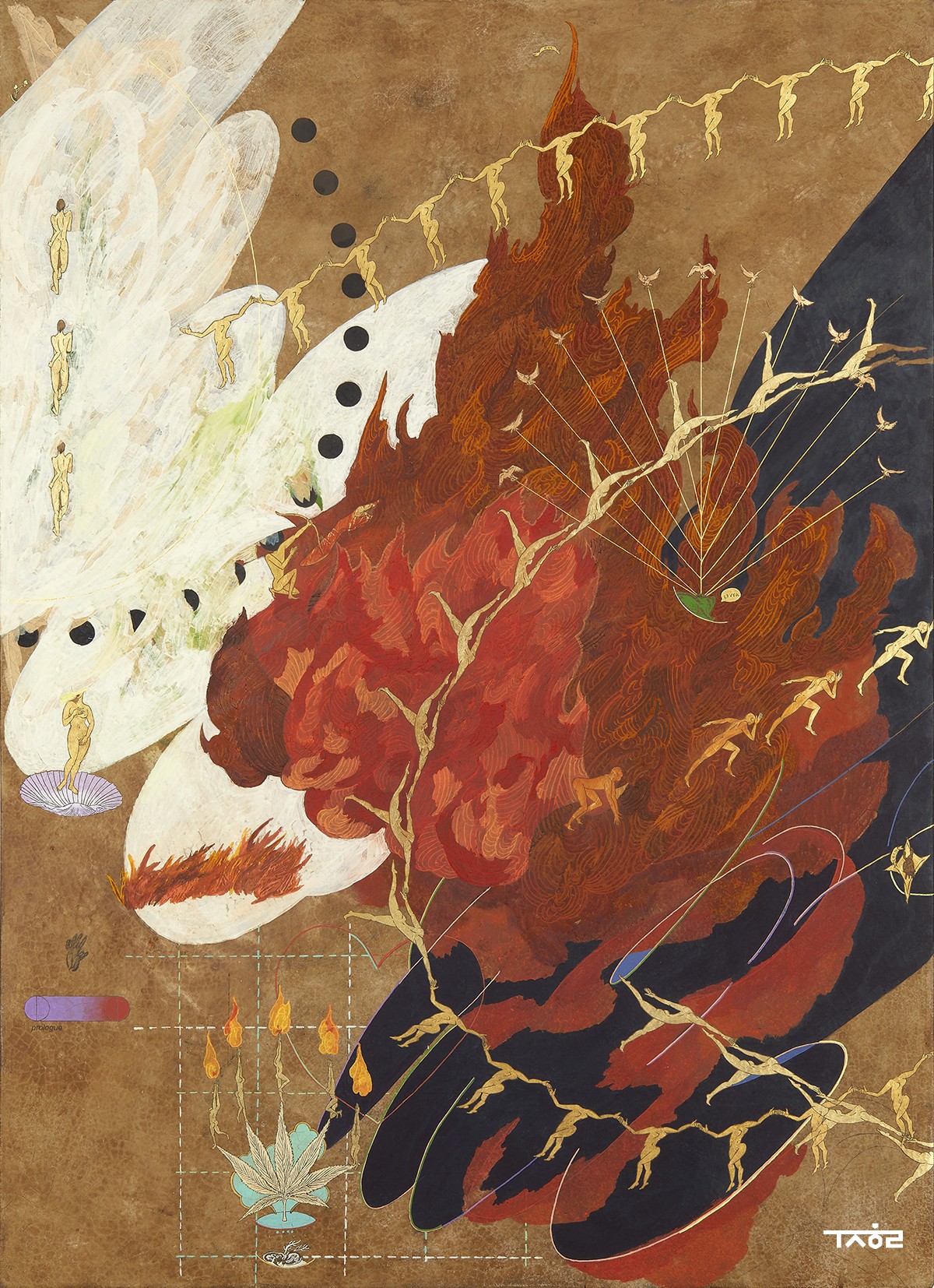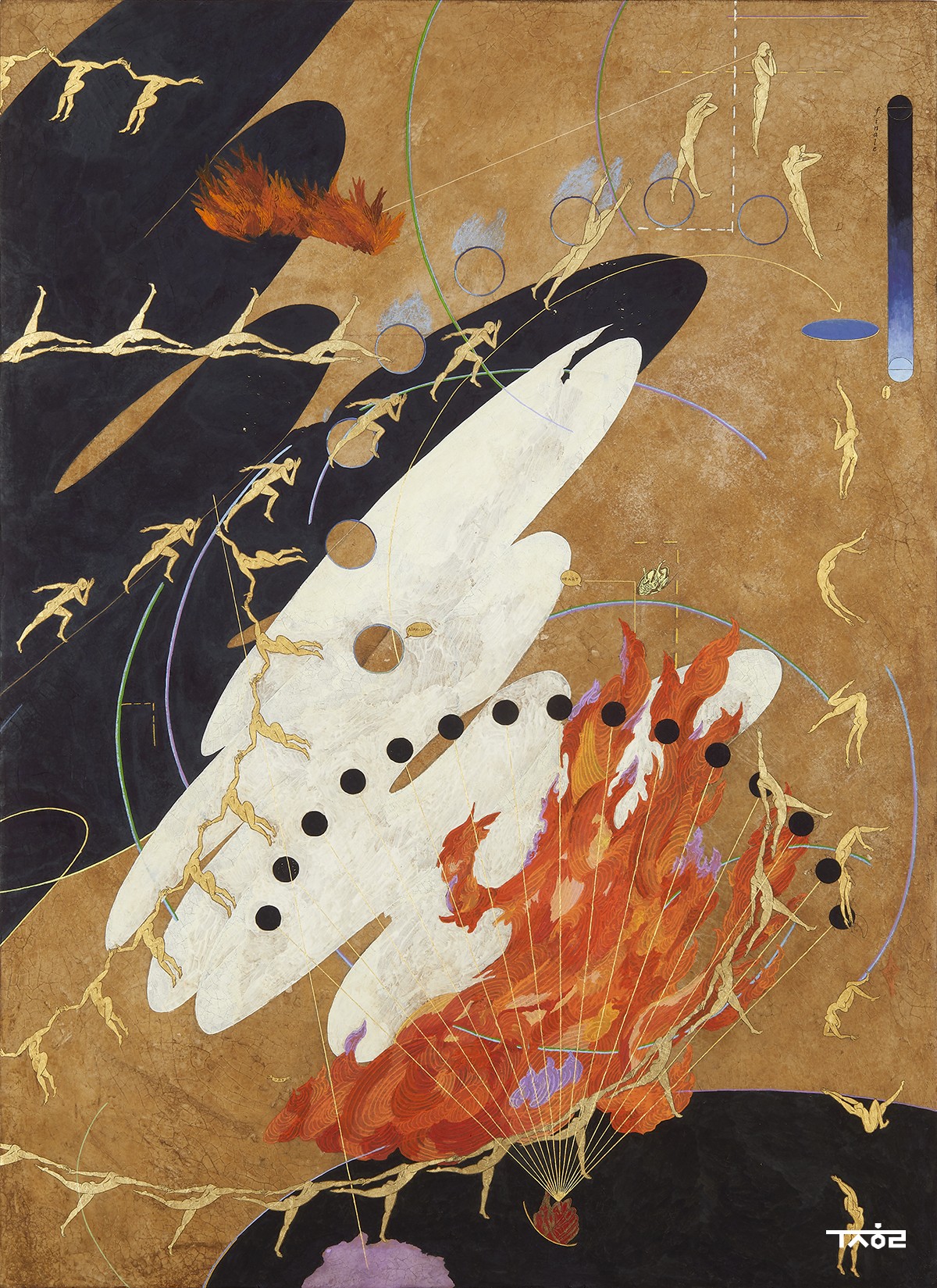우민정 | WOO Min-jung

작품을 확대하려면 클릭해보세요.
Prologue
Prologue
2021, 마, 황토, 백토에 채색, 180×130cm
Color on dried claysoil
작가노트Artist's Note
그림을 하나의 창으로 가정해 본다.
창은 문과 달리 말이 통하지 않는다.
그저 바라보고 미루어 짐작하게 된다.
오래되어 뿌옇게 먼지가 쌓인 창문 안으로
무엇인가 움직이는 것들이 어른거린다.
비밀을 알아내기 위해서,
뿌연 벽에 가까이 뺨을 가져다 댄다.
어루만져 보고, 상처를 긁어내 틈을 내고, 핥아 본다.
흙을 발라 만든 창을 통해서,
금색의 작은 점들이 어렴풋이 보인다.
깜빡거린다. 점들이 반복하여 찍힌다.
이 점들이 당위와 배경을 가지고 움직이게 되었다.
움직이는 모양이 새겨지듯 명료한 선으로 나타나고 흩어진다.
또 다른 움직임이 어른거리다 사라진다.
이 궤적은 배경과 현재 시점의 위치를 가진 특정한
풍경이 아니라 명확히 잡히지 않고 흩어지는 무드와 같다.
이것을 하나하나 쫓아 그 그림자를 하나하나 반복하듯
새겨보고 동시에 중첩하여 나타내었다.
창은 문과 달리 말이 통하지 않는다.
그저 바라보고 미루어 짐작하게 된다.
오래되어 뿌옇게 먼지가 쌓인 창문 안으로
무엇인가 움직이는 것들이 어른거린다.
비밀을 알아내기 위해서,
뿌연 벽에 가까이 뺨을 가져다 댄다.
어루만져 보고, 상처를 긁어내 틈을 내고, 핥아 본다.
흙을 발라 만든 창을 통해서,
금색의 작은 점들이 어렴풋이 보인다.
깜빡거린다. 점들이 반복하여 찍힌다.
이 점들이 당위와 배경을 가지고 움직이게 되었다.
움직이는 모양이 새겨지듯 명료한 선으로 나타나고 흩어진다.
또 다른 움직임이 어른거리다 사라진다.
이 궤적은 배경과 현재 시점의 위치를 가진 특정한
풍경이 아니라 명확히 잡히지 않고 흩어지는 무드와 같다.
이것을 하나하나 쫓아 그 그림자를 하나하나 반복하듯
새겨보고 동시에 중첩하여 나타내었다.
Let's assume a painting like a window.
Unlike doors, windows do not communicate.
It just stares and guesses.
Something moves inside the dusty window
that has long been neglected.
To find a secret, you put your cheek closely
on the murky wall.
You gently stroke, crack by scratching wound,
and lick it. Gold colored tiny dots are seen
through the window made of soil.
The dots are flickering.
They are repeatedly dotted. These dots move with
reasoning and circumstances.
As if their movements are inscribed,
the dots make a clear line and disperse.
Another movement appears and then disappears.
This trajectory is not a certain present view with any
circumstances but a mood that cannot be captured
but disperse. Every trajectory has been chased,
and its shadow is engraved and expressed in layers.
Unlike doors, windows do not communicate.
It just stares and guesses.
Something moves inside the dusty window
that has long been neglected.
To find a secret, you put your cheek closely
on the murky wall.
You gently stroke, crack by scratching wound,
and lick it. Gold colored tiny dots are seen
through the window made of soil.
The dots are flickering.
They are repeatedly dotted. These dots move with
reasoning and circumstances.
As if their movements are inscribed,
the dots make a clear line and disperse.
Another movement appears and then disappears.
This trajectory is not a certain present view with any
circumstances but a mood that cannot be captured
but disperse. Every trajectory has been chased,
and its shadow is engraved and expressed in layers.
작가의 다른 작품Other Works



 Prev
Prev List
List Next
Next